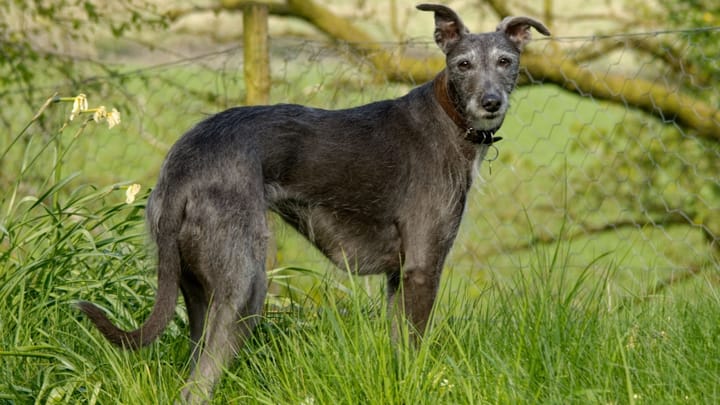Lurcher


The Lurcher is a cross between a sighthound (Greyhound, Whippet or Saluki, for example) with another breed of dog, often a sheepdog or terrier. Originating in Great Britain and Ireland, the Lurcher was historically used for coursing, thanks to its exceptional hunting skills. This crossbreed combines the speed and agility of a sighthound with the intelligence and hardiness of the working breeds. Today, Lurchers are valued not only as hunting dogs, but also as loyal and affectionate pets.
|
Life expectancy |
The Lurcher has a life expectancy of between 12 and 15 years |
|
Temperament |
|
|
Size |
Large
|
|
Adult size |
Female
Between 22 and 31 in
Male
Between 22 and 31 in
|
|
Adult weight |
Female
Between 55 and 77 lb
Male
Between 55 and 77 lb
|
|
Coat colour
|
Black White Brown Blue Brindle |
|
Type of coat
|
Short Hard |
|
Eye colour
|
Brown
|
|
Purchase price |
The Lurcher costs between £400 and £1000 |
More details about the Lurcher
Lurcher: Origins and history
The origins of the Lurcher date back to the British Isles, mainly in Great Britain and Ireland. The history of Lurchers is closely linked to that of travellers, who used these dogs for hunting small game, especially hares.
The Lurcher was created in the 14th century, a time when only nobility was allowed to own greyhounds in Britain. To circumvent this restriction, the lower classes crossed greyhounds with other working dogs, creating the Lurcher, an effective and versatile hunting dog. The name "Lurcher" derives from the word "lur," meaning "thief" in Romani, due to their frequent use in poaching.
Although the Lurcher is not recognized as an official breed by major dog organisations, it is valued for its affectionate and playful nature. Modern breeding efforts tend to preserve the Lurcher's temperament rather than focusing on specific physical characteristics.
Lurcher: Characteristics
Lurcher: Behaviour
Training a Lurcher
Due to its intelligence and eagerness to please, the Lurcher is generally easy to train. These dogs respond well to positive and consistent training methods, making them obedient companions.
Lurcher: Lifestyle
Breed compatibility Lurcher
Lurcher: Purchase price
The cost of a Lurcher depends on the parent breeds, the breeder and the location of the litter.
In addition to the initial cost, you'll need to factor in expenses for veterinary care, vaccinations, parasite treatment, a balanced diet and accessories.
Lurcher: Shedding
Average
Lurchers are generally considered to shed moderately, but this depends on the parent breeds they come from. They may have a short, lightly textured coat, or a double coat, which will influence how much grooming they require. Like many dogs, Lurchers typically experience an increase in shedding during the moulting seasons in spring and autumn. Regular brushing can help manage shedding.
Lurcher: Health
Lurchers are generally healthy, hardy dogs, but like all breeds, they can be prone to certain health problems. Regular visits to the vet will help keep them feeling their best.
Lurchers can be sensitive to the heat due to their relatively thin coats. They are prone to heatstroke, especially during the summer months. It's important to provide them with fresh water and shade, and to keep them indoors during periods of high heat to avoid any health problems.
Lurchers tend to tolerate the cold better than the heat, but those with very short coats may need protection in colder months.
Lurchers can be prone to weight gain if they are not given enough exercise or are overfed. Monitoring their diet and providing them with regular exercise is essential to maintaining a healthy weight.
While they are often thought of as a hardy crossbreed, Lurchers can be prone to some common illnesses.
They may be predisposed to:
- Hip dysplasia
- Eye problems
- Bloating (gastric torsion)
- Sensitivity to heat and cold
It is important for Lurcher owners to be aware of these potential problems and to see a veterinarian regularly for preventative health checks to keep their dog healthy.







